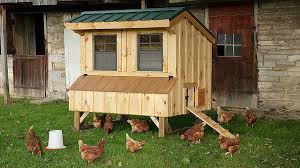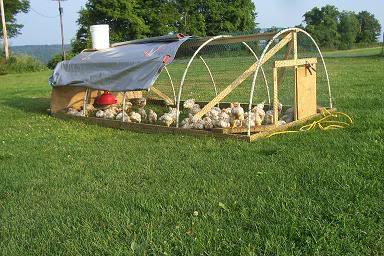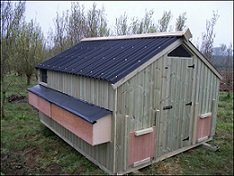|
Search this site for keywords or topics..... | ||

Custom Search
| ||
Chicken Coop Types
It may seem odd that flock owners can choose between several different chicken coop types. After all, how many ways are there to house chickens? Turns out, there are several fundamentally different ways, determined largely by flock size, human access to the inside, and whether the coop will be mobile or stationary. So let's look at the three different major chicken coop types before we get into more specific details.
Small Chicken Coops

The above coop is one of several available from Eberly Barns, a barn buiding company based in SE Pennsylvania. Visit their website.
For small flocks, say a dozen birds or less,
sometimes the coop is sized only large enough for the birds’ most basic needs –
roosts and nesting. In this instance,
the coop is essentially a small box, either on the ground or up on a stand, and
it is usually housed within a larger exercise yard of some kind. The roosts are up underneath the coop’s
roof. Nest boxes are accessed from the
inside by the birds, and from outside by the egg-gathering flock owner. Even the birds’ feed and water is moved
outside. This setup can work quite well
for small flocks in mild climates, and particularly in urban situations where a
small coop footprint is strongly preferred.
Chicken Tractors

The above chicken tractor is just one of literally hundreds of designs on this theme. This one was built with a combination of dimensional wood and PVC poles, with wire mesh over the frame to contain the birds. The whole assembly is on a lightweight wood frame for each moves. The tarp in back provides shelter against both intense sun and wind-driven rain. Note the gravity-fed water bucket on top, and the red feeder inside the tractor towards the back. Read about this particular design, and its performance over nine years of service, at The Deliberate Agrarian Blog.
Another example of a small coop is the approach now commonly
known as the chicken tractor. This
structure is a lightweight, mobile shelter which not only offers protected
access to fresh grazing. These
structures can vary dramatically in size, shape, and materials used. The largest I’ve personally ever seen could
house up to 50 young broiler birds, and the birds spent their entire lives
within it. Common design features are a
small covered area to protect from rain, snow and intense sun, a fenced area
for grazing, a roosting area and nest boxes when used for layer hens, and
typically a small feeder and waterer to supplement the grazing. The design of these chicken tractors must be
carefully considered to provide two things: a) sufficient area for growing
birds, and b) the structural rigidity needed to safely move repeatedly, while
being light enough to move. Variations
exist for structures which are light enough to be moved by one or two people,
perhaps with the assistance of an equipment dolly or built-in wheels. Other tractors are designed to be moved by a
4x4 vehicle, ATV or tractor.
Large Stationary Chicken Coops

This handsome example of a good sized layer hen coop comes from the UK. Note the full-sized door giving access to the inside, the bank of nestboxes along the side, and the two chicken-sized hatches on either side of the main door. Proof that a poultry house can be perfectly functional yet attractive. Visit this coop's builder at their website.
A third example of chicken coops are perhaps most familiar to most people – a small outbuilding which not only shelters the birds, but also is sized to allow the flock owner to work inside. These buildings are intended for flocks of any size, but the larger the flock the more substantial the building. These coops are occasionally mounted on runners to allow for limited moves from one location to another. However, most of them are intended to remain stationary. Furthermore, many of them are reinforced to provide protection from predators and vermin. These buildings are also often intended to be used for many years, so provisions must be made to allow for thorough cleanings and repair if/as needed.
Even these
larger buildings share a variety of design features. First, the feed and water are set up inside,
so the coop needs to have easy access by the flock owner. Second, if the coop is to be used by layers,
it will need to provide roosting space and nest boxes. The nest boxes must also be easy to access,
either from inside or outside, for daily egg-gathering. Furthermore, the nest boxes should be easy to
clean out periodically. And third, these
buildings are generally intended to be all-weather shelters, so they will need
to be designed to withstand the worst of whatever the yearly weather may throw
at it. That might mean carefully sized
ventilation for the worst of summer heat, heavier roofing for snow loads, stout
construction and anchoring for high winds, heat supplementation to prevent
frozen water in winter, or possibly all the above. These buildings must also include some
consideration for both vermin and predator protection since they are
stationary, and thus constitute a target which both vermin and predators will
continue to work at penetrating over time.
Poultry Books
Sponsored Products
Our Successful Farming and Ranching Books

We released our very first self-published book. The Chicken Coop Manual in 2014. It is a full color guide to conventional and alternative poultry housing options, including 8 conventional stud construction plans, 12 alternative housing methods, and almost 20 different design features. This book is available on Amazon.com and as a PDF download. Please visit The Chicken Coop Manual page for more information.

Rabbit Colonies: Lessons Learned
We started with rabbits in 2002, and we've been experimenting with colony management ever since. Fast forward to 2017, when I decided to write another book, this time about colony management. The book is chock-full of practical information, and is available from both Amazon and as a PDF download. Please visit the Rabbit Colonies page for more information.
The Pastured Pig Handbook
We are currently working on our next self-published book: The Pastured Pig Handbook. This particular book addresses a profitable, popular and successful hog management approach which sadly is not yet well documented. Our handbook, will cover all the various issues involved with pastured hog management, including case studies of numerous current pastured pig operations. If you have any questions about this book, please Contact Us.